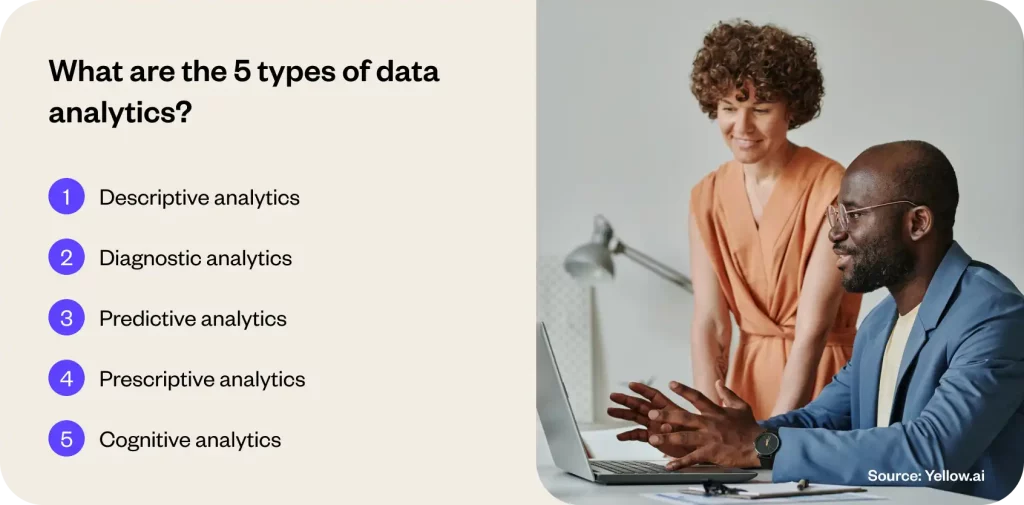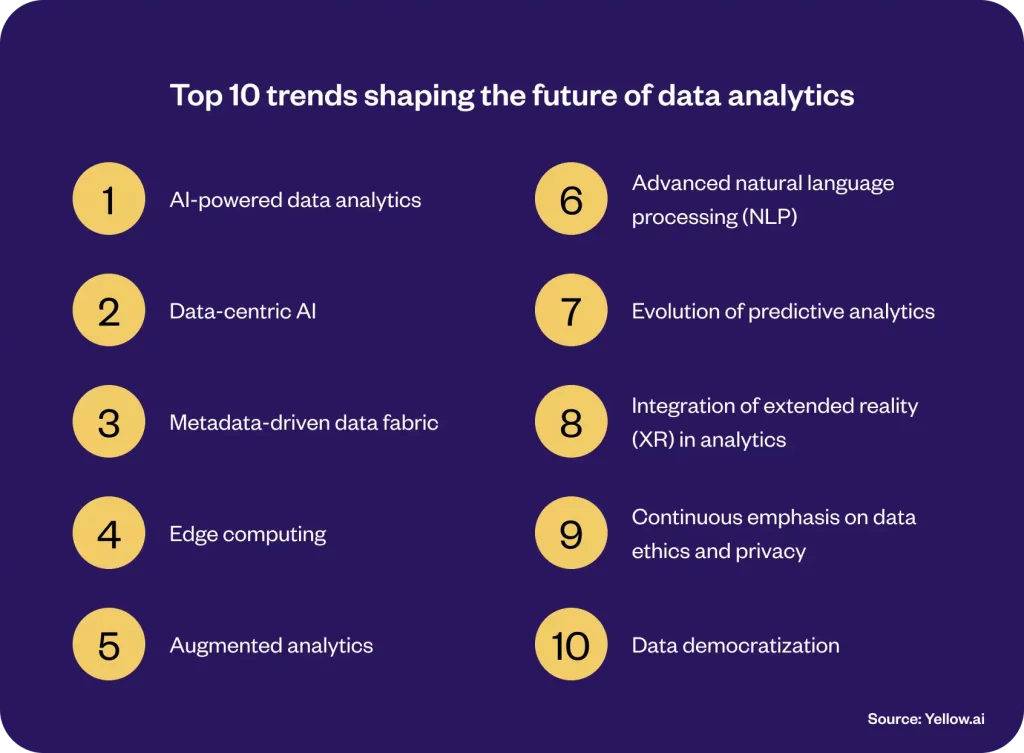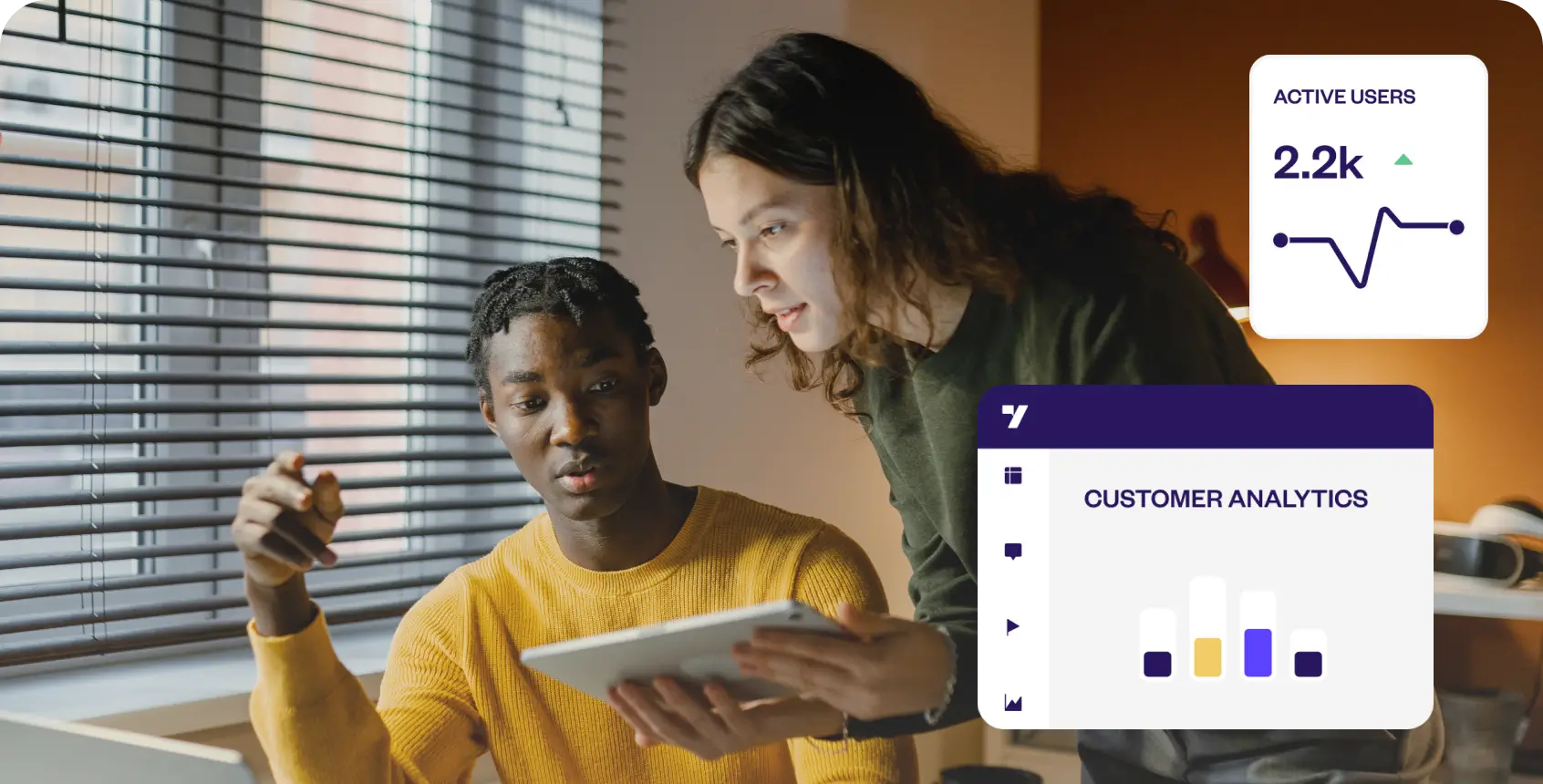Executive summary:
In 2024, any business focused on growth and maintaining a competitive edge must grasp the top data analytics trends. These trends are at the forefront of technological innovation, offering essential tools that enhance operational efficiency, deepen customer insights, and enable informed decision-making to drive business expansion. This blog will introduce the top 10 data analytics trends you must embrace to position your business ahead of the curve. By keeping these existing and emerging data analytics trends in mind, you can obtain critical insights, optimize your business operations, and drive informed decision-making.
However, you must be aware that, like most technological fads, the trends in data analytics don’t stay static. This domain is dynamic in nature, and it demands one to be observant. What are the most important concepts and solutions in the field of data and analytics in the upcoming year? Which innovative methods and technologies are businesses adopting, and why? This blog addresses such concerns to advance your business’s performance and sustain the competition. At the same time, the focus is more on the “why” instead of the “what” and “how,” these trends provide scalable, tangible advantages to businesses.
What is data analytics?
Simply put, data analytics involves collecting, organizing, and analyzing data to uncover useful insights that help in making smart decisions. It uses a variety of tools and techniques to work with different kinds of data—whether it’s structured, semi-structured, or unstructured. Although data analytics has gained popularity recently, it isn’t a new field.
With data analytics, you can transform plain old raw data into actionable insights. It’s a game-changer for any business looking to streamline operations, spot trends, or even predict what’s next. It also gives you a leg up on the competition and can seriously upgrade how your customers experience your services or products.
So, why should you care? Because data analytics helps you decode everything from market trends to what your customers really want. It lets you tackle big, complex data sets and make sense of them. But this is just the beginning! Let’s dive a little deeper and explore the different types of data analytics and what’s trending in this field. There’s a whole world of opportunities here that can help you grow your business in ways you might not have imagined yet.
Real-time, data-driven AI analytics for enterprises

What are the 5 types of data analytics?
As you have come this far, the blog has given you some clarity about data analytics. But to grasp its essence better, be aware that it is divided into several categories. Let’s learn about 5 types of data analytics, as it will help you zero in on the suitable variant to employ in your business.

1. Descriptive analytics
Often, surrounded by numbers, graphs and charts, many might feel stuck in a data deluge. This is when descriptive analytics emerges as your reliable interpreter. It decodes the raw data into a compelling narrative. You can call it the Herodotus of data analytics, chronicling the past to answer the crucial question: “What just went down?” Such insight can help you reflect on what might have gone right or wrong in the past. Based on them, you can track performance, get information about your customer’s behavior and make judicious decisions.
2. Diagnostic analytics
Whenever you feel trapped in a data conundrum weaved with hidden reasons, diagnostic analytics steps in as the sharpest detective. Using a magnifying glass, it unravels the mystery and identifies the “why” behind your data’s behavior. You may call it the Sherlock Holmes of the data world, who explores and explains the causative factors behind the occurrence of past events. Apart from acting as a detective, it also converts insights into action. With diagnostic analytics, you can analyze why something happened previously and thus optimize processes, refine marketing strategies and improve customer experience.
3. Predictive analytics
This type of data analytics is predictive in nature. As the term suggests, it foretells or predicts future trends, possible outcomes, potential risks and rewarding opportunities by employing and examining historical data and detecting patterns. It works by harnessing statistical modeling, machine learning, and deep learning. Predictive analytics prove useful in demand forecasting, fraud detection, targeted marketing and maintenance optimization.
4. Prescriptive analytics
As you have guessed, prescriptive analytics recommends the best solutions and actions one must take based on predicted outcomes. Prescriptive analytics is like the Gandalf the Gray of data analytics, guiding you for what will happen and what you should do about it. Beyond predicting trends or identifying patterns, it leverages sophisticated algorithms and simulations to recommend specific actions to optimize outcomes. It takes the guesswork out of decision-making. Prescriptive analytics primarily finds its application in financial planning, supply chain optimization, or customer retention.
5. Cognitive analytics
It leverages the combined assistance of artificial intelligence (AI) and machine learning (ML). Cognitive analytics can automate data processing and create in-depth insights using these two tools. As you pick this type of data analytics, you will be relieved of rigid spreadsheets and numerical grids. Cognitive analytics dives headfirst into the messy, unstructured world of text, images, and audio, the data that traditional methods often leave untouched. It acts as your decoder ring, employing NLP and ML to extract hidden meaning, uncover trends, and open valuable insights that would otherwise remain buried.
Top 10 trends shaping the future of data analytics
According to a report by Statista, 64 zettabytes of data are generated annually globally. It equates to 64 trillion gigabytes of data from 23.8 billion connected devices. The amount of data generated by more than 41 billion connected devices will surpass 180 zettabytes by the year 2025. All these numbers vouch that data will continue to occupy the center stage. Organizations and businesses striving to excel must integrate data analytics in their systems. However, keeping a constant tab on this space can be a tad overwhelming. Fret not, there is a solution for it and you may find them in the latest happenings, most stable patterns and emerging movements. But there is a ‘catch’.
As discussed at the beginning of this blog, the trends in data analytics keep changing and evolving in alignment with the transformation in the technology space. Thus, it can perplex new entrants like you to decide which works best for your business. To ease your ambiguity, here is a thorough jot down of the top 10 trends shaping the future of data analytics. The list goes like this:

- AI-powered data analytics
- Data-centric AI
- Metadata-driven data fabric
- Edge computing
- Augmented analytics
- Advanced natural language processing (NLP)
- Evolution of predictive analytics
- Integration of extended reality (XR) in analytics
- Continuous emphasis on data ethics and privacy
- Data democratization
1. AI-powered data analytics
With the advent of AI, the world has opened to unimaginable possibilities. Data analytics has jumped on this bandwagon and integrated AI into its functioning. AI-powered data analytics is revolutionizing this field, equipping machines to automate several complex tasks, locate discreet patterns, and produce deeper insights. It particularly harnesses the benefits of machine learning (ML). Unlike traditional analytics, which need IT analysts, ML-based models can monitor data, identify abnormalities, and notify the concerned teams in real time without external input. ML models may yield insights from any data sample. They can analyze millions of data points for correlations and score high in precision.
2. Data-centric AI
It is a fascinating trend in data analytics that doesn’t revolve around letting the AI bask in the glory alone. Instead, as the name indicates, data-centric AI focuses on getting the most out of AI to improve data processing, evaluation, analysis, and exegesis. Moreover, it strives to establish a more data-centric AI development methodology.
3. Metadata-driven data fabric
A data fabric is a virtual layer that unifies data across different sources, making it easier to access and analyze. Metadata, or data about data, is crucial in managing and governing this fabric. This trend in data analytics highlights the significance of metadata, which provides context and facilitates seamless data integration and analysis from diverse sources.
4. Edge computing
This technology or trend fetches analytics or computing power closer to the data origin or source. Thus, edge computing decentralizes data processing and facilitates real-time data analysis, faster insights, and better decision-making. It primarily holds immense significance in areas like IoT and connected devices.
5. Augmented analytics
This trend in data analytics is quite exciting and innovative. As the name hints, it clubs traditional data analysis with augmented reality (AR) and virtual reality (VR) technologies to visualize and interact with data in immersive environments. That’s how it enhances understanding and facilitates collaboration. It harnesses ML and AI power, transforming data analysis beyond anyone’s imagination. Likewise, employing ML and NLP, it automates and processes information or data. Augmented analytics allows users and stakeholders to experience data more intuitively and interactively.
6. Advanced natural language processing (NLP)
Software engineering, semantics, and artificial consciousness all have several subfields, and natural language processing (NLP) is one of them. It revolves around computer-human linguistic interaction. In particular, it is concerned with enhancing computers’ intelligence by programming them to recognize, evaluate, and interpret massive amounts of data originating from natural languages. With a constantly evolving technology, NLP is becoming highly progressive and refined. This trend talks about it in length. Advanced NLP enables machines to decipher, generate and process complex human language with enhanced efficacy. This leads to more natural and intuitive interactions with data analysis tools.
7. Evolution of predictive analytics
You must consider the evolution process and recent developments to understand predictive analytics trends. Over time, there has been a massive transformation in predictive analytics, making them more sophisticated. Predictive analytics embraces advanced techniques and tools such as causal AI, deep learning, and machine learning models to presage future events, explain their reasons, account for uncertainty, and create more robust and reliable forecasts. Predictive analytics moves past basic forecasting to more complex scenarios, such as foretelling customer churn, pinpointing anomalies, and optimizing marketing drives.
8. Integration of extended reality (XR) in analytics
It is one of the most fascinating data analytics trends. In sync with the constantly evolving technologies, the realm of data analytics is plunging into the immersive ecosystem; moving beyond mere charts and graphs. The recent years, including the current one, witnessed thrilling improvements in Extended Reality (XR)-powered analytics. Imagine exploring complex datasets as three-dimensional landscapes, pinpointing trends by navigating through interactive charts, and drilling into granular details in a virtual environment. Thus, the integration of XR technologies is finding its way into data analytics, allowing users to visualize and interact with data in a more enriching and engaging way. It has resulted in better data understanding, visualization and prudent decision-making. But 2024 promises even bolder leaps. You may anticipate mixed reality (MR) overlaying data onto real-world scenarios, making analytics visual and contextually aware.
9. Continuous emphasis on data ethics and privacy
This data analytics trend brings one of the most debated topics under the attention, i.e., the ethical use of data. As data collection, evaluation, and usage are becoming more pervasive and widespread in recent years, data ethics and privacy concerns have emerged and are likely to grow if required measures aren’t taken. Thus, businesses must prioritize responsible data practices, ensure compliance with regulations, adhere to data privacy rules and implement robust data governance frameworks. If you want your business to thrive, ensure you are emphasizing enough on data ethics and privacy while working with data analytics.
10. Data democratization
As the name specifies, this data analytics trend focuses on democratizing data or making the advantages of data analytics highly accessible to all users, irrespective of their skill levels. It results from the development of self-service analytics solutions for the users. Data democratization authorizes businesses to make data-driven decisions. Under this trend, in an organizational setup, everyone, from senior executives and front-line employees to stakeholders, can access, comprehend, use, evaluate, and extract insights from data. However, you must bear in mind that building a data-savvy and inclusive company is not a one-and-done deal. It demands a conscious strategy and constant fidelity from leadership.
These are just a few significant trends in data analytics. They go beyond this list of top 10 trends in this space. As technology continues to evolve rapidly, we are bound to witness and experience newer fads in data analytics, some of which are already creating a buzz.
Summing up the data analytics trends
After this in-depth analysis and discussion, anyone would agree with Peter Sondergaard’s words, i.e., “Data is the 21st century’s oil, and analytics is the combustion engine.” Data analytics trends helps businesses like yours with that filtering and get insights, information, suggestions and more to thrive and drive success. It is best to remember that mere knowledge about it isn’t enough. You must be highly attentive, observant, and up-to-date on the trends in data analytics. While a few have longer life spans, most of them are volatile in nature. Likewise, not every trend suits all business domains. Futuristic platform Yellow.ai has taken a lead to provide businesses from across the sector real time data-driven AI analytics.
Boost your business efficiency with the right data analytics solutions

Essential conversational AI KPIs, including deflection rate, goal completion rate (GCR), customer satisfaction, first response time (FRT), etc., may be derived by businesses using our Dynamic Automation Platform (DAP). The entry of chatbot analytics is already revolutionizing how businesses are functioning. In this regard, the mention of Yellow.ai chatbots can give you some in depth understanding. With our AI-powered chatbots you can boost client engagement with more than 20 real-time actionable insights. They also enable organizations to make informed decisions using customer conversations and chatbot metrics, including user feedback, top customer flows, user acquisition, bot performance, and bot activity. Get meaningful, shareable and actionable reports. You can easily build custom analytics using our Data Explorer, a business intelligence tool.
To sum it up, let’s accept that the data deluge shows no signs of slowing, and businesses that embrace the evolution of data analytics will lead the pack. With this blog, you can study and select the data analytics trends that fit the bill. Adopt these cutting-edge approaches, harness the power of your information, and watch your business flourish in the data-driven future. Stay watchful, and you can always come back here to learn about the trends in data analytics that will rule the world not just in 2024 but in years to come.
Frequently asked questions (FAQs)
What is the trend in data analytics?
One notable trend in data analytics in 2024 is data-centric artificial intelligence, which emphasizes the importance of data quality and structure in building AI models. This approach prioritizes data as a critical asset, focusing on enhancing data accuracy, consistency, and accessibility to improve AI outcomes and decision-making processes.
What are the top three trends in data analytics?
The top three trends in data analytics are: 1) Big Data Analytics: Harnessing vast volumes of data from various sources to uncover hidden patterns, correlations, and insights; 2) Data Science: Combining statistical analysis, data mining, and predictive analytics to understand complex data; 3) Artificial Intelligence: Utilizing advanced algorithms and machine learning techniques to automate data processing and generate predictive models.
What is the future trend of data analysts?
Future data analysts are anticipated to use advanced tools to deliver deeper insights, forecast trends, and recommend actions. This requires a larger skill set, including a solid grasp of machine learning techniques and the capacity to incorporate predictive analytics into their analysis.
What are data trends?
Data trends refer to the patterns and movements identified in data over a period. For example, using repeated annual customer satisfaction surveys, businesses can track how their customer satisfaction levels change year over year. Data trends help in understanding the effectiveness of business strategies and initiatives, allowing companies to make data-driven adjustments to enhance performance and customer satisfaction.






















